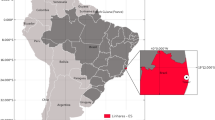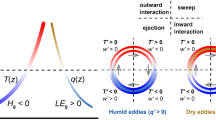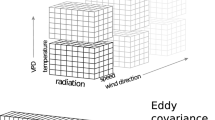Abstract
Observations from the Horizontal Array Turbulence Study (HATS) field program are used to examine the attenuation of measured scalar fluxes caused by spatial separation between the vertical velocity and scalar sensors. The HATS data show that flux attenuation for streamwise, crosswind, and vertical sensor displacements are each a function of a dimensionless, stability-dependent parameter n m multiplied by the ratio of sensor displacement to measurement height. The scalar flux decays more rapidly with crosswind displacements than for streamwise displacements and decays more rapidly for stable stratification than for unstable stratification. The cospectral flux attenuation model of Kristensen et al. agrees well with the HATS data for streamwise sensor displacements, although it is necessary to include a neglected quadrature spectrum term to explain the observation that flux attenuation is often less with the scalar sensor downwind of the anemometer than for the opposite configuration. A simpler exponential decay model provides good estimates for crosswind sensor displacements, as well as for streamwise sensor displacements with stable stratification. A model similar to that of Lee and Black correctly predicts flux attenuation for a combination of streamwise and crosswind displacements, i.e. as a function of wind direction relative to the sensor displacement. The HATS data for vertical sensor displacements extend the near-neutral results of Kristensen et al. to diabatic stratification and confirm their finding that flux attenuation is less with the scalar sensor located below the anemometer than if the scalar sensor is displaced an equal distance either horizontally or above the anemometer.
Similar content being viewed by others
References
Antonia RA, Phan-Thien N, Chambers AJ (1980) Taylor’s hypothesis and the probability density functions of temporal velocity and temperature derivatives in a turbulent flow. J Fluid Mech 100: 193–208
Barthlott C, Drobinski P, Fesquet C, Dubos T, Pietras C (2007) Long-term study of coherent structures in the atmospheric surface layer. Boundary-Layer Meteorol 125: 1–24
Favre A, Gaviglio J, Fohr JP (1964) Répartition spectrale de corrélations spatio-temporelles de vitesse, en couche limite turbulente. In: Görtler H(eds) Proceedings of the 11th international congress of applied mechanics, Munich, 1964. Springer-Verlag, Berlin, pp 878–888
Favre A, Gaviglio J, Dumas R (1967) Structure of velocity space-time correlations in a boundary layer. Phys Fluids 10(Part II): S138–S145
Hill R (1989) Implications of Monin–Obukhov similarity theory for scalar quantities. J Atmos Sci 46: 2236–2244
Horst TW (1997) A simple formula for attenuation of eddy fluxes measured with first-order-response scalar sensors. Boundary-Layer Meteorol 82: 219–233
Horst TW, Oncley SP (2006) Corrections to inertial-range power spectra measured by CSAT3 and Solent sonic anemometers. Boundary-Layer Meteorol 119: 375–395
Horst TW, Kleissl J, Lenschow DH, Meneveau C, Moeng C-H, Parlange MB, Sullivan PP, Weil JC (2004) HATS: field observations to obtain spatially filtered turbulence fields from crosswind arrays of sonic anemometers in the atmospheric surface layer. J Atmos Sci 61: 1566–1581
Kaimal JC, Finnigan JJ (1994) Atmospheric boundary layer flows. Oxford University Press, UK, p 289
Kaimal JC, Wyngaard JC, Haugen DA (1968) Deriving power spectra from a three-component sonic anemometer. J Appl Meteorol 7: 827–837
Kaimal JC, Wyngaard JC, Izumi Y, Cote OR (1972) Spectral characteristics of surface-layer turbulence. Q J R Meteorol Soc 98: 563–589
Kristensen L, Mann J, Oncley SP, Wyngaard JC (1997) How close is close enough when measuring scalar fluxes with displaced sensors?. J Atmos Ocean Technol 14: 814–821
Laubach J, McNaughton KG (1998) A spectrum-independent procedure for correcting eddy fluxes measured with separated sensors. Boundary-Layer Meteorol 89: 445–467
Lee X, Black TA (1994) Relating eddy correlation sensible heat flux to horizontal sensor separation in the unstable atmospheric surface layer. J Geophys Res 99(D9): 18545–18553
Lumley JL, Panofsky HA (1964) The structure of atmospheric turbulence. Wiley, New York, p 239
Mizuno T, Panofsky HA (1975) The validity of Taylor’s hypothesis in the atmospheric surface layer. Boundary-Layer Meteorol 9: 375–380
Moore CJ (1986) Frequency response corrections for eddy correlation systems. Boundary-Layer Meteorol 37: 17–35
Nicholls S, Readings CJ (1981) Spectral characteristic of surface layer turbulence over the sea. Q J R Meteorol Soc 107: 591–614
Panofsky HA, Thompson DW, Sullivan DA, Moravek DE (1974) Two-point velocity statistics over Lake Ontario. Boundary-Layer Meteorol 7: 309–321
Powell DC, Elderkin CE (1974) An investigation of the application of Taylor’s hypothesis to atmospheric boundary layer turbulence. J Atmos Sci 31: 990–1002
Schotanus P, Nieuwstadt FTM, DeBruin HAR (1983) Temperature measurement with a sonic anemometer and its application to heat and moisture fluctuations. Boundary-Layer Meteorol 26: 81–93
Taylor GI (1938) The spectrum of turbulence. Proc Roy Soc London A 165: 476–484
Van Dijk A (2002) Extension to 3D of “The effect of line averaging on scalar fluxes measured with a sonic anemometer near the surface” by Kristensen and Fitzjarrald. J Atmos Ocean Technol 19: 80–82
Villalobos FJ (1997) Correction of eddy covariance water vapour flux using additional measurements of temperature. Agric For Meteorol 88: 77–83
Wyngaard JC (1988) Flow-distortion effects on scalar flux measurements in the surface layer: implications for sensor design. Boundary-Layer Meteorol 42: 19–26
Author information
Authors and Affiliations
Corresponding author
Rights and permissions
About this article
Cite this article
Horst, T.W., Lenschow, D.H. Attenuation of Scalar Fluxes Measured with Spatially-displaced Sensors. Boundary-Layer Meteorol 130, 275–300 (2009). https://doi.org/10.1007/s10546-008-9348-0
Received:
Accepted:
Published:
Issue Date:
DOI: https://doi.org/10.1007/s10546-008-9348-0




